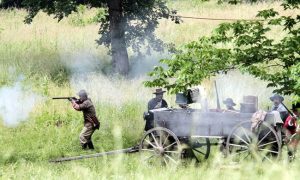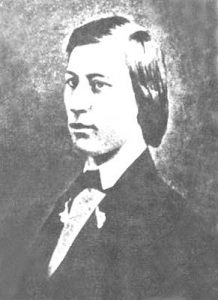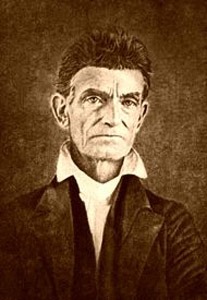Henry Clay Pate was the leader of a gang of border ruffians during the territorial struggles of Kansas.
Pate was born on April 21, 1833, into a slaveholding family in Bedford County, Virginia, and grew up to be an ardent supporter of the pro-slavery cause. He entered the University of Virginia in 1848 but left after only two years and moved to Kentucky. Afterward, he drifted to Cincinnati, Ohio where he organized a party of Virginians to travel to Westport (Kansas City), Missouri in April 1855 with the intent “of swelling the emigration from the South and making Kansas a slave state.”
After arriving in Westport, Pate began publishing his own newspaper variously called the “Border Star,” “Frontier News,” or “Star of the Empire.” He was also engaged as the local correspondent for the St. Louis Missouri Republican, covering the Kansas battle including the meetings of the Bogus Legislature. Believing the Northern states were exploiting the South, stating:
“The longer we submit to the blasting monopoly of the northern merchants, the more difficult will it be to cast off the yoke of oppression under which we live.”
He was particularly bitter in his denunciations of the Free-State advocates. He commanded a detachment of the Territorial Militia which was organized under Governor Wilson Shannon’s call, most of this militia being composed of citizens of southern states.
After five pro-slavery settlers were brutally murdered by John Brown as part of the Pottawatomie Massacre in 1856, Pate set out to capture Brown. Pate and his men caught up with Brown near Palmyra in Douglas County on June 2, 1856 and the two sides began to fight. Known as the Battle of Black Jack, Brown and another free stater, Colonel Edwin V. Sumner, captured Pate along with some of his troops who surrendered without much resistance. Sumner released Pate on June 8th.
“H. C. Pate told his friends: I went to take Old Brown and Old Brown took me.” – John Brown, summer 1856
The following September he again became warlike and wrote to Governor John Geary that he would organize and command the settlers of Lykins (Miami) County, “for the protection of the polls,” if the governor would give him a commission. To this proposal, Governor Geary responded:
“While thanking you most kindly for your suggestions and for your friendly offer, I have made every necessary arrangement to protect the bonafide citizens of this territory in the exercise of their right of suffrage.”
This was not to Pate’s liking, as it was not the “bonafide” settlers he wanted to protect but the voters who would come over from Missouri to carry the election, as they had done on previous occasions. Finding that the governor would not aid his scheme, he dropped out of Kansas affairs.

A re-creation of the Battle of Black Jack in which Pearson fought with John Brown. Photo courtesy Baldwin City Signal.
When the Civil War broke out, he enlisted in the Confederate Army and rose to Lieutenant Colonel of the 5th Virginia Calvary.
He was killed, along with famous Confederate Major General J.E.B. Stuart, in the Battle of Yellow Tavern near Richmond, Virginia, on May 11, 1864. Major General Philip Sheridan claimed a victory for the Union army but lost 625 men. They captured nearly 300 Confederates and reclaimed 300 Union soldiers held captive.
©Kathy Alexander/Legends of Kansas, updated updated February 2023.
Also See:
Territorial Kansas & the Struggle for Statehood
Sources:
Blackmar, Frank W.; Kansas: A Cyclopedia of State History, Vol I; Standard Publishing Company, Chicago, IL 1912.
Kansapedia
Kansas Bogus Legislature


